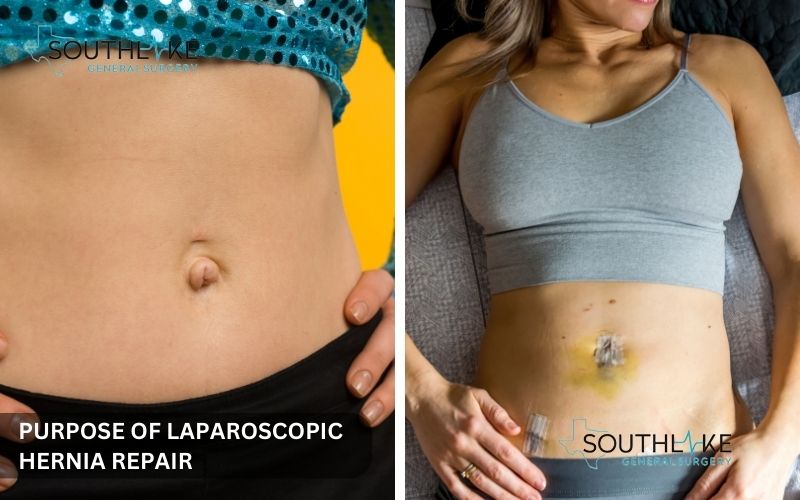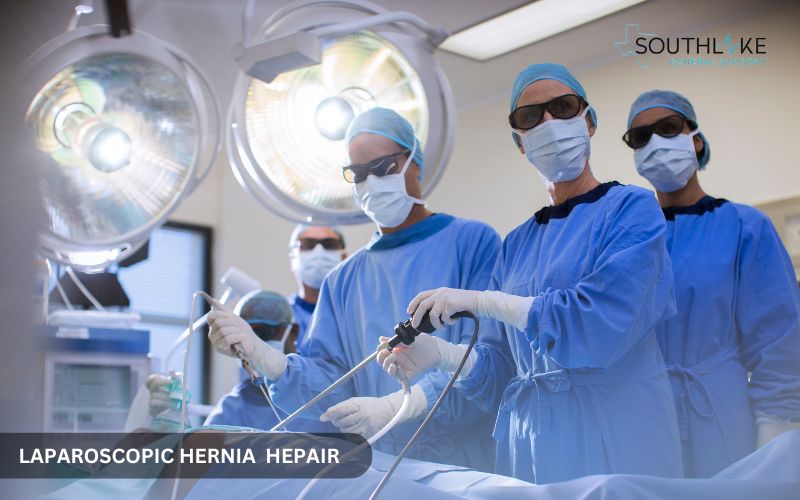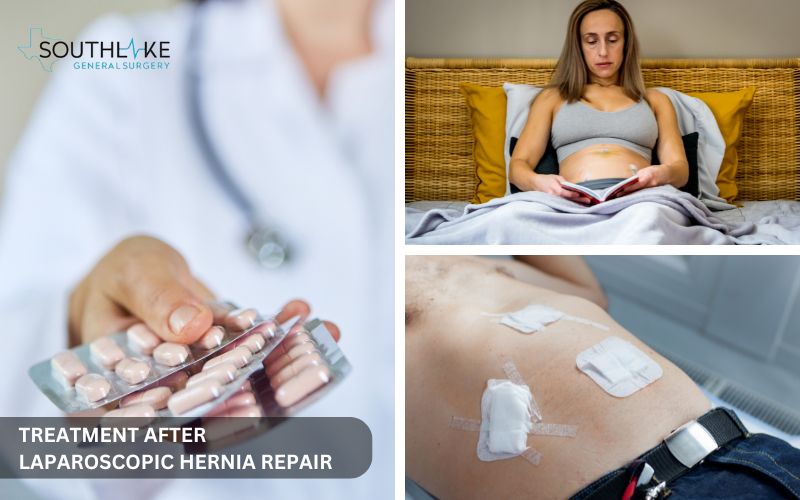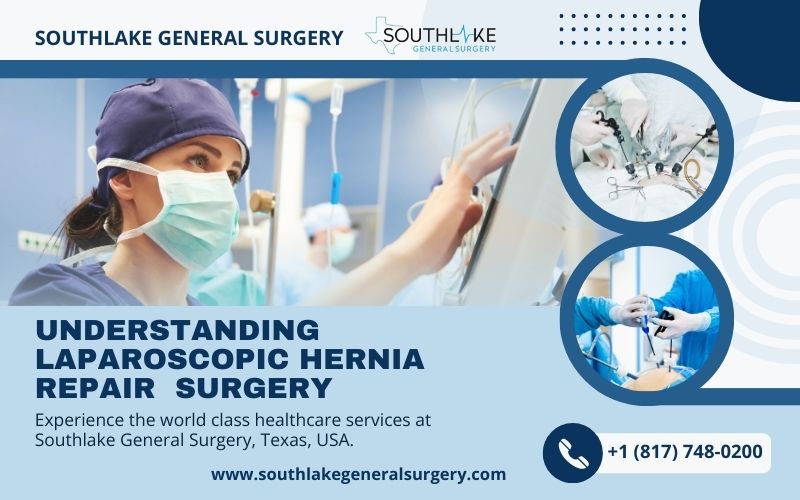Laparoscopic hernia repair surgery is a surgical method used to treat abdominal wall hernias. This is a minimally invasive surgical procedure. During this process, the patient’s abdomen will be punctured with a few tiny holes to make room for the insertion of a thin, lighted tube known as a laparoscope.
The laparoscope gives the surgeon an enlarged view of the interior anatomy, which enables them to make accurate repairs to the hernia while causing the least amount of damage to the tissue around it.
It is common practice to execute the operation while the patient is under general anesthesia. Following the procedure, the patient will normally only need to spend a short duration of time in the hospital and will recover in a reasonably short amount of time.
What is the purpose of Laparoscopic Hernia Repair Surgery?

Repairing the injured muscular wall of the abdominal cavity is the primary goal of laparoscopic hernia repair, as this allows the hernia to be treated with minimal disruption to the surrounding tissue.
Complications, such as bowel blockage, can arise from hernias because they impede the regular functioning of the abdominal muscles. The hernia can be repaired using minimally invasive surgery, which means the patient will experience less pain and discomfort after surgery and have a quicker recovery time.
If a patient has one of these hernias, laparoscopic repair may be an option:
- Inguinal Hernia
- Hiatal Hernia
- Umbilical Hernia
- Ventral Hernia
In addition to preventing potentially fatal complications, laparoscopic hernia surgery lessens the likelihood that the hernia may return in the future. Furthermore, it is frequently prescribed to people who are at high risk for developing a hernia.
How is the laparoscopic hernia repair performed?

In most cases, a laparoscopic hernia surgery takes between one and two hours to finish. The patient will be carefully watched during this period to make sure they are both safe and comfortable.
During laparoscopic surgery, the patient is put to sleep under general anesthesia, and the surgeon makes a series of tiny incisions to introduce the laparoscope and other surgical tools. The laparoscope allows the surgeon a magnified view of the inside anatomy, allowing for more accurate hernia surgeries.
After the treatment is complete, the incisions are sutured shut and a bandage is placed over the wound.
How to get ready for a Laparoscopic Hernia Repair?
Before undergoing a laparoscopic hernia repair treatment, it is essential for the patient to consult with their physician regarding their previous medical history as well as any drugs that they may currently be taking.
Alterations to the patient’s diet and lifestyle may also be recommended by the attending physician in the days leading up to the operation.
It’s also crucial to follow the attending doctor’s orders when conducting any tests or making any preparations before the surgery.
The patient should also keep in mind that they may be requested to fast before the treatment, and they should avoid taking any aspirin or anti-inflammatory medications for at least one week prior to the date that they are scheduled to have surgery.
What are the risk factors with Laparoscopic Hernia Repair Surgery?
Recurrence of the hernia and potentially fatal consequences can be lessened with laparoscopic hernia repair. It is possible to repair hernias with this surgery, which is both secure and efficient.
However, like other surgical procedures, laparoscopic hernia surgery is not without its share of potential complications. That includes:
- infection
- internal bleeding
- injury to nerves
- damage to the organs
All the above are the nearby potential outcomes of this risk. In addition, there is a possibility that scarring will occur after the treatment, and there is also a possibility that the hernia could return.
How can laparoscopic hernia repair help?
To treat a variety of hernias with minimal disturbance to surrounding tissue, laparoscopic hernia surgery is an effective and safe option.
Laparoscopic hernia repair has many benefits over open hernia surgery, such as:
- a quicker recovery time
- less post-operative pain
- little scarring
- lower risk of recurrence
- lower risk of life-threatening complications
In addition, laparoscopic hernia surgery can be utilized as a prophylactic strategy in patients who are at risk for hernia development.
In general terms, laparoscopic hernia repair is a safe and successful method of treating hernias with minimal disruption to the surrounding tissue.
Treatment after Laparoscopic Hernia Repair

Following the completion of the laparoscopic hernia repair process, the patient will normally remain in the recovery room for a short period of time.
During this time, they will be closely observed for any potential issues that may arise. After being discharged from the hospital, it is essential to adhere to any instructions provided by the attending physician. These instructions may include:
- taking medications exactly as they have been prescribed.
- refraining from engaging in strenuous physical activity.
- heavy lifting.
- driving.
- sexual activity for at least two weeks while the body recovers, and so on.
It is essential to maintain a clean and dry area around the incision until it has completely healed to lessen the likelihood of experiencing issues following the surgical procedure.
It is important to keep an eye on the areas around your incisions to check for any signs of infection, like redness, swelling, or discharge. Patients should notify their doctors immediately if they experience any symptoms suggestive of infection or severe discomfort.
Prognosis
With a high success rate and minimal risk of complications, laparoscopic hernia repair has a positive prognosis. After the operation, most people feel a dramatic improvement in their hernia-related suffering and pain and can get back to their regular routine with little to no downtime.
It is unlikely that the condition would return if the patient received timely postoperative treatment and followed the doctor’s instructions. In conclusion, laparoscopic hernia surgery is a reliable and safe method for alleviating hernia-related discomfort for good.
Make an Appointment
For more information on Laparoscopic Hernia Repair Surgery and consultation with Dr. Valeria Simone MD, at Southlake General Surgery, Texas, USA. You can contact our healthcare expert today for a quick appointment at +1(817) 748-0200.
Medically Reviewed By: Dr. Valeria Simone MD
Board-certified General Surgeon at Southlake General Surgery, Texas, USA.
Follow us on Facebook and YouTube.
References:
- Hope WW, Pfeifer C. Laparoscopic Inguinal Hernia Repair. [Updated 2023 Jul 3]. In: StatPearls [Internet]. Treasure Island (FL): StatPearls Publishing; 2025 Jan-. Available from: https://www.ncbi.nlm.nih.gov/books/NBK430826/
- Carter J, Duh QY. Laparoscopic repair of inguinal hernias. World J Surg. 2011 Jul;35(7):1519-25. doi: 10.1007/s00268-011-1030-x. PMID: 21400014; PMCID: PMC3140939.
- Armijo PR, Pokala B, Flores L, Hosein S, Oleynikov D. Current state of robotic use in inguinal hernia repair: a survey of minimally invasive hernia surgeons. Updates Surg. 2020 Mar;72(1):179-184. doi: 10.1007/s13304-020-00709-6. Epub 2020 Mar 5. PMID: 32141046.
- Solaini L, Cavaliere D, Avanzolini A, Rocco G, Ercolani G. Robotic versus laparoscopic inguinal hernia repair: an updated systematic review and meta-analysis. J Robot Surg. 2022 Aug;16(4):775-781. doi: 10.1007/s11701-021-01312-6. Epub 2021 Oct 5. PMID: 34609697; PMCID: PMC9314304.

